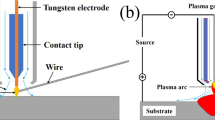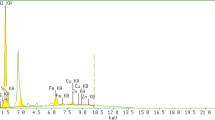Abstract
The silver-copper oxide–based reactive air brazing technique was developed as a method of joining complex-shaped ceramic parts. To investigate the viability of this approach for high-temperature application, a series of air-brazed alumina joints were independently exposed to either oxidizing or reducing atmosphere at 800 °C for 100 h. Those samples that were thermally aged in air maintained good joint strength, similar to that of the original as-brazed samples. Microstructural analysis revealed no significant change in joint microstructure after long-term oxidation at elevated temperature, indicating excellent stability of the Ag–CuO-based filler metal in this environment. On the other hand, exposure of the air-brazed alumina joints to hydrogen under the same aging conditions resulted in a measurable decrease in joint strength. Scanning electron microscope analysis conducted on the fracture surfaces of the broken hydrogen-exposed specimens indicated that the source of joint failure was debonding along the interface between the filler metal and alumina substrate. This was due in large part to internal reduction of CuO precipitates within the filler metal to copper and accompanied by the simultaneous formation of porosity at these sites, both within the bulk of the joint as well as along the filler metal/substrate interfaces. Pore formation was noticeably present in filler metals prepared with a high concentration of copper oxide.
Similar content being viewed by others
References
K. Eichler, G. Solow, P. Otschik, and W. Schaffrath: Degradation effects at sealing glasses for the SOFC, in Proc. 4th Eur. Solid Oxide Fuel Cell Forum edited by A.J. McEvoy (European Fuel Cell Forum, Oberrohrdorf, Switzerland, 2000), pp. 899–906.
M. Singh, T. Shibayama, T. Hinoki, M. Ando, Y. Katoh, A. Kohyama: Joining of silicon carbide composites for fusion energy applications. J. Nucl. Mater. 283–287B, 1258 (2000).
E. Pippel, J. Woltersdorf, P. Colombo, A. Donato: Structure and composition of interlayers in joints between SiC bodies. J. Eur. Ceram. Soc. 17, 1259 (1997).
J.H. Kim, Y.C. Yoo: Bonding of alumina to metals with Ag–Cu–Zr brazing alloy. J. Mater. Sci. Lett. 16, 1212 (1997).
M. Powers: Active metal brazing for ceramic-to-metal joining, in Proceedings 1997 International Systems Packaging Symposium (Int. Microelecton. & Packaging Soc., Reston, VA, 1997), p. 124.
R. Arroyave, T.W. Eagar: Metal substrate effects on the thermochemistry of active brazing interfaces. Acta Mater. 51, 4871 (2003).
M. Zhu, D.D.L. Chung: Active brazing alloy containing carbon fibers for metal-ceramic joining. J. Am. Ceram. Soc. 77, 2712 (1994).
J.Y. Kim, J.S. Hardy, K.S. Weil: Effects of CuO content on the wetting behavior and mechanical properties of a Ag–CuO braze for ceramic joining. J. Am. Ceram. Soc. 88, 2521 (2005).
J.S. Hardy, J.Y. Kim, K.S. Weil: Joining mixed conducting oxides using an air-fired electrically conductive braze. J. Electrochem. Soc. 151, J43 (2004).
J.Y. Kim, J.S. Hardy, K.S. Weil: Silver-copper oxide based reactive air braze (RAB) for joining yttria-stabilized zirconia. J. Mater. Res. 20, 636 (2005).
K.S. Weil, J.Y. Kim, J.S. Hardy: Reactive air brazing: A novel method of sealing SOFCs and other solid-state electrochemical devices. Electrochem. Solid-State Lett. 8, A133 (2005).
J.Y. Kim, J.S. Hardy, K.S. Weil: Use of aluminum in air-brazing aluminum oxide. J. Mater. Res. 19, 1717 (2004).
A.M. Meier, P.R. Chidambaram, G.R. Edwards: A comparison of the wettability of copper-copper oxide and silver-copper oxide on polycrystalline alumina. J. Mater. Sci. 30, 4781 (1995).
C.C. Shüler, A. Stuck, N. Beck, H. Keser, U. Täck: Direct silver bonding—An alternative for substrates in power semiconductor packaging. J. Mater. Sci. Mater.-Electron. 11, 389 (2000).
R.L. Klueh, W.W. Mullins: Some observations on hydrogen embrittlement of silver. Trans. Metall. Soc. AIME 242, 237 (1968).
P. Singh, Z.G. Yang, V. Viswanathan, J.W. Stevenson: Observations on the structural degradation of silver during simultaneous exposure to oxidizing and reducing environments. J. Mater. Eng. Perform. 13, 287 (2004).
Z.B. Shao, K.R. Liu, L.Q. Liu, H.K. Liu, S. Dou: Equilibrium phase diagrams in the systems PbO–Ag and CuO–Ag. J. Am. Ceram. Soc. 76, 2663 (1993).
J.T. Darsell, K.S. Weil: The effect of Pd additions on the invariant reactions in the Ag–CuOx system. J. Phase Equil. Diff. 27, 92 (2006).
Y. Yoshino, T. Shibata: Structure and bond strength of a copper–alumina interface. J. Am. Ceram. Soc. 75, 2756 (1992).
D. Chatain, F. Chabert, V. Ghetta, J. Fouletier: New experimental setup for wettability characterization under monitored oxygen activity: II, wettability of sapphire by silver-oxygen melts. J. Am. Ceram. Soc. 77, 197 (1994).
T.B. Massalski, H. Okamoto, P.R. Subramanian, L. Kacprzak: Binary Alloy Phase Diagrams 2nd ed. (ASM International, Materials Park, OH, 1990), Vol. 1, p. 66.
Author information
Authors and Affiliations
Corresponding author
Rights and permissions
About this article
Cite this article
Kim, J.Y., Hardy, J.S. & Weil, K.S. High-temperature tolerance of the silver-copper oxide braze in reducing and oxidizing atmospheres. Journal of Materials Research 21, 1434–1442 (2006). https://doi.org/10.1557/jmr.2006.0178
Received:
Accepted:
Published:
Issue Date:
DOI: https://doi.org/10.1557/jmr.2006.0178




